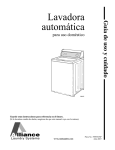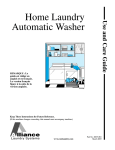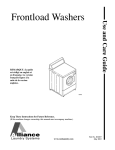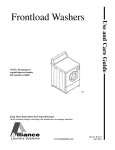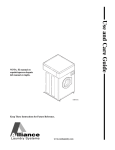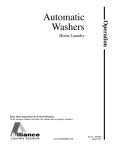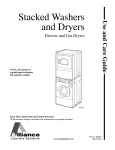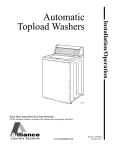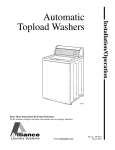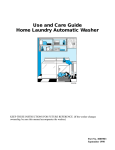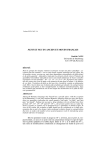Download Alliance Laundry Systems Home Laundry Automatic Washers Installation manual
Transcript
Use and Care Guide Automatic Washers Home Laundry W001C W001C Para bajar una copia de estas instrucciones en español, visite www.comlaundry.com. Keep These Instructions for Future Reference. (If this machine changes ownership, this manual must accompany machine.) www.comlaundry.com Part No. 39091R5 July 2007 WARNING For your safety and to reduce the risk of fire or an explosion, do not store or use gasoline or other flammable vapors and liquids in the vicinity of this or any other appliance. W022 39091 © Copyright, Alliance Laundry Systems LLC – DO NOT COPY or TRANSMIT 1 Table of Contents Safety Information.............................................................................. Explanation of Safety Messages........................................................... Important Safety Instructions ............................................................... 3 3 3 Use and Care ....................................................................................... Before Washing .................................................................................... Prepare Wash Load .......................................................................... Sort ................................................................................................... Pretreat ............................................................................................. Loading the Washer.............................................................................. Load Articles.................................................................................... Load Sizes ........................................................................................ Water Level...................................................................................... Water..................................................................................................... Water Hardness ................................................................................ Iron ................................................................................................... Wash Temperature ........................................................................... Laundry Tips......................................................................................... Washing Temperature Guide................................................................ Optional Features.................................................................................. Bleach Dispenser ............................................................................. Fabric Softener Dispenser................................................................ Special Care .......................................................................................... Starching .......................................................................................... Knits ................................................................................................. Permanent Press ............................................................................... Washing Special Items ......................................................................... Washing Concerns ................................................................................ Stain Removal....................................................................................... 5 5 5 5 6 6 6 6 7 7 7 8 8 9 10 10 10 10 11 11 11 12 13 14 15 Maintenance ........................................................................................ Washer Maintenance ............................................................................ Cold Weather Care........................................................................... Care of Your Washer ....................................................................... Replacing Hoses............................................................................... Filter Screens ................................................................................... Vacations and Extended Non-Use ................................................... Reinstallation of Shipping Materials ............................................... Motor Overload Protector..................................................................... Before You Call for Service ................................................................. If Service Is Required ........................................................................... Information for Handy Reference......................................................... 19 19 19 19 19 19 19 20 20 21 22 23 © Copyright 2007, Alliance Laundry Systems LLC All rights reserved. No part of the contents of this book may be reproduced or transmitted in any form or by any means without the expressed written consent of the publisher. 2 © Copyright, Alliance Laundry Systems LLC – DO NOT COPY or TRANSMIT 39091 Safety Information Explanation of Safety Messages Important Safety Instructions Throughout this manual and on machine decals, you will find precautionary statements (“DANGER,” “WARNING,” and “CAUTION”) followed by specific instructions. These precautions are intended for the personal safety of the operator, user, servicer, and those maintaining the machine. Save These Instructions DANGER WARNING To reduce the risk of fire, electric shock, serious injury or death to persons when using your washer, follow these basic precautions: W023 Indicates an imminently hazardous situation that, if not avoided, will cause severe personal injury or death. WARNING Indicates a hazardous situation that, if not avoided, could cause severe personal injury or death. CAUTION 1. Read all instructions before using the washer. 2. Refer to the GROUNDING INSTRUCTIONS in the INSTALLATION manual for the proper grounding of the washer. 3. Do not wash articles that have been previously cleaned in, washed in, soaked in, or spotted with gasoline, dry-cleaning solvents, or other flammable or explosive substances as they give off vapors that could ignite or explode. 4. Do not add gasoline, dry-cleaning solvents, or other flammable or explosive substances to the wash water. These substances give off vapors that could ignite or explode. IMPORTANT: The word “IMPORTANT” is used to inform the reader of specific procedures where minor machine damage will occur if the procedure is not followed. 5. Under certain conditions, hydrogen gas may be produced in a hot water system that has not been used for two weeks or more. HYDROGEN GAS IS EXPLOSIVE. If the hot water system has not been used for such a period, before using a washing machine or combination washer-dryer, turn on all hot water faucets and let the water flow from each for several minutes. This will release any accumulated hydrogen gas. THE GAS IS FLAMMABLE. DO NOT SMOKE OR USE AN OPEN FLAME DURING THIS TIME. NOTE: The word “NOTE” is used to communicate installation, operation, maintenance or servicing information that is important but not hazard related. 6. Do not allow children to play on or in the washer. Close supervision of children is necessary when the washer is used near children. This is a safety rule for all appliances. Indicates a hazardous situation that, if not avoided, may cause minor or moderate personal injury or property damage. Additional precautionary statements (“IMPORTANT” and “NOTE”) are followed by specific instructions. 39091 © Copyright, Alliance Laundry Systems LLC – DO NOT COPY or TRANSMIT 3 Safety Information 7. Before the washer is removed from service or discarded, remove the lid to the washing compartment. 8. Do not reach into the washer if the washtub or agitator is moving. 9. Do not install or store the washer where it will be exposed to water and/or weather. 10. Do not tamper with the controls. 11. Do not repair or replace any part of the washer, or attempt any servicing unless specifically recommended in the User-Maintenance instructions or in published User-Repair instructions that you understand and have the skills to carry out. 12. To reduce the risk of an electric shock or fire, DO NOT use an extension cord or an adapter to connect the washer to the electrical power source. 13. Use your washer only for its intended purpose, washing clothes. 14. ALWAYS disconnect the washer from electrical supply before attempting any service. Disconnect the power cord by grasping the plug, not the cord. 15. Install the washer according to the INSTALLATION INSTRUCTIONS. All connections for water, drain, electrical power and grounding must comply with local codes and be made by licensed personnel when required. Do not do it yourself unless you know how! 16. To reduce the risk of fire, clothes which have traces of any flammable substances such as vegetable oil, cooking oil, machine oil, flammable chemicals, thinner, etc. or anything containing wax or chemicals such as in mops and cleaning cloths, must not be put into the washer. These flammable substances may cause the fabric to catch on fire by itself. 17. Do not use fabric softeners or products to eliminate static unless recommended by the manufacturer of the fabric softener or product. 19. Replace worn power cords and/or loose plugs. 20. Be sure water connections have a shut-off valve and that fill hose connections are tight. CLOSE the shut-off valves at the end of each wash day. 21. Lid MUST BE CLOSED any time the washer is to agitate or spin. DO NOT bypass the lid switch by permitting the washer to agitate or spin with the lid open. A brake will stop the washtub within seconds if the lid is opened during spinning. If the washtub does not stop when the lid is opened, remove the washer from use and call the service person. 22. Always read and follow manufacturer’s instructions on packages of laundry and cleaning aids. Heed all warnings or precautions. To reduce the risk of poisoning or chemical burns, keep them out of the reach of children at all times (preferably in a locked cabinet). 23. Always follow the fabric care instructions supplied by the garment manufacturer. 24. Never operate the washer with any guards and/or panels removed. 25. DO NOT operate the washer with missing or broken parts. 26. DO NOT bypass any safety devices. 27. Failure to install, maintain, and/or operate this washer according to the manufacturer's instructions may result in conditions which can produce bodily injury and/or property damage. NOTE: The WARNING and IMPORTANT SAFETY INSTRUCTIONS appearing in this manual are not meant to cover all possible conditions and situations that may occur. Common sense, caution and care must be exercised when installing, maintaining, or operating the washer. Always contact your dealer, distributor, service agent or the manufacturer about any problems or conditions you do not understand. 18. Keep your washer in good condition. Bumping or dropping the washer can damage safety features. If this occurs, have your washer checked by a qualified service person. 4 © Copyright, Alliance Laundry Systems LLC – DO NOT COPY or TRANSMIT 39091 Use and Care 2. Sort by Fabric and Construction Before Washing Prepare Wash Load COTTONS AND LINENS PERMANENT PRESS Empty Pockets and Cuffs Make sure all pockets are empty and turn them inside out. One bobby pin, metal or plastic toy, nail or sharp object in a load can catch laundry and cause tears. Facial tissue left in a pocket will produce extreme “lint.” A crayon or lipstick in a wash load may cause stains that cannot be removed. Roll down cuffs and shake out grass, sand, and gravel. SYNTHETICS, BLENDS & POLY KNITS DELICATES Mend Rips and Tears W309I Little holes can become bigger in the washer. Mend holes and tears before placing garments in the washer. Figure 2 3. Sort by Care Label Close Zipper and Fasten Hooks These can catch on garments in a wash load and tear them. Tie belts and sashes so they won’t wind around clothes. COLD WARM Check for Colorfastness Squeeze a portion of garment in warm or hot sudsy water. If the color bleeds or runs, wash the item separately in cold water. HOT Sort W310I Proper sorting is easy if you follow a few guidelines: 1. Sort by Color WHITES DARKS LIGHTS NON-COLORFAST 4. Sort by Type and Amount of Soil Children’s play clothes, as well as work clothes, will need extra treatment. Lightly soiled clothes can become dingy if washed with heavily soiled items. W308I Figure 1 39091 Figure 3 5. Sort Lint “Shedders” from Lint “Receivers” Some fabrics attract lint and should not be washed with lint-shedding loads. Lint shedders are cottons, terry towels, chenille bedspreads, rugs, and clothes which have been heavily bleached. Lint receivers are synthetics, permanent or durable press, knits (including socks), corduroy, and other smooth fabrics. © Copyright, Alliance Laundry Systems LLC – DO NOT COPY or TRANSMIT 5 Use and Care Pretreat Load Sizes Pretreat shirt collars and cuffs with a pre-wash product or liquid detergent when placing them in the washer. Before washing, treat special stains with bar soap, liquid detergent or a paste of water and granular detergent. Use a pretreat soil and stain remover. Small 3-4 perm. press dress shirts OR 1 twin sheet, 1 pillow case Loading the Washer OR 1-2 lightweight dresses Load Articles Load items by the amount of space they take up, not by their weight. Mix large and small items in a load to get the best washing results. Medium 6-7 perm. press shirts OR Drop items loosely into the washtub. The bulk of the clothes rather than the weight will determine load size. Do not pack items in or wrap them around the agitator. Overloading can cause poor cleaning, excessive wrinkling, and tears. 2 twin sheets, 2 pillow cases OR 8 standard bath towels, 6 wash cloths Large 10-11 perm. press shirts OR 2 full size sheets, 2 pillow cases, 2 pair men’s pajamas OR W118I Figure 4 Items should move freely through the wash water for best cleaning results. Items should roll over, sink, and then reappear. When washing very large items, do not fill washtub as full as with other loads. 12 standard bath towels, 4 hand towels, 4 wash cloths Extra Large (OPTIONAL) 8-9 shirts and 5 pair polyester pants OR 2 queen size sheets, 4 pillow cases, 2 nightgowns 1 pair men’s pajamas OR 1 queen size bedspread Reset (OPTIONAL) Use the RESET if agitation has started and more water is needed for the load. 6 © Copyright, Alliance Laundry Systems LLC – DO NOT COPY or TRANSMIT 39091 Use and Care Water Water Level Water Hardness RIGHT SOFT WATER 0 to 10 milligrams per liter MODERATELY HARD WATER 300 milligrams per liter HARD WATER 500 milligrams per liter WRONG VERY HARD WATER Over 500 milligrams per liter W120I Figure 6 W119I Figure 5 NOTE: Illustrations shown without fabric softener dispenser. Your washer may have a fabric softener dispenser. The water level in your washer should fit the size of your wash load. Small loads will use lower water levels. There must be enough water in the washtub to allow items to move and turn over freely. Overloading the washtub can result in poor washing and rinsing. Overloading may also cause wrinkling and tearing of items. IMPORTANT: If in doubt, always use a higher water level. Most average loads will require a water setting of Large. Failure to have the correct volume of water relative to the load will increase the incidence of excessive lint. 39091 Water hardness is measured in grains per gallon (G.P.G.) or parts per million (P.P.M.). To learn your water hardness, call your Water Department or State Extension Service. Hard water will not remove soil as well as soft water and can result in gray, dingy laundry. To get clothes clean in hard water, use a phosphate detergent or use more detergent if using a nonphosphate detergent. Do not use soap. Hard Water May Be Softened By: 1. A mechanical water softener installed in your home. 2. The use of a packaged water conditioner. Soft Water Water should be soft enough to allow soaps and detergents to remove soil effectively. Clothes will be whiter and brighter when washed and rinsed in soft water. © Copyright, Alliance Laundry Systems LLC – DO NOT COPY or TRANSMIT 7 Use and Care Iron Warm Water If iron is present in the water, the clothes may become an all-over yellow or they may be stained with brown or orange spots or streaks. Iron is not always visible in the water. By using warm water, there is less chance of color loss in items. Warm water also reduces wrinkling in permanent press items. Use with light and moderate soils, non-colorfast or dark colors, permanent press, silks, woolens, nylon, and acrylic. Solutions to Iron Problems The installation of a water softener will remove small amounts of iron from the water supply. The installation of an iron filter may be necessary for more severe cases. If the iron comes from the pipes, it may be sufficient just to let the water run into the empty washer for about one minute. This may help to clear the pipes. Spin this water out of the washtub before starting the wash. If iron comes from the water heater, drain the heater occasionally to remove the rust. If the Iron Condition Cannot Be Corrected Prepare the wash water first by adding detergent (not soap), then add the clothes to the washtub. Use a phosphate detergent. The phosphate content of a detergent is listed on the package side panel. Add a nonprecipitating water conditioner to the washtub just before the rinse water enters. Do not use fabric softener in the rinse water if a packaged water conditioner is used. Iron with Chlorine Bleach The use of chlorine bleach with water that contains iron will make the rust discoloration worse. Use an “all fabric” bleach. Cold Water Cold water is less effective in cleaning than hot or warm water, but it does minimize wrinkling and color fading. Use it for washing extra-sensitive clothes and for rinsing all fabrics. Energy You can save energy when washing by following a few guidelines: 1. Heating water accounts for the greatest energy expense when washing. Save on heating water by using cold rinses. 2. Wash full loads, but do not overload. 3. Use soak cycles for heavily soiled items to reduce wash times. 4. Select a shorter wash time for lightly soiled items. 120 °F/49 °C HOT 100 °F/37 °C WARM 60 °F/18 °C COLD Wash Temperature W121I Hot Water Figure 7 Hot water will give the best results of cleaning and sanitizing, but it is not suitable for all items. It is best for sturdy whites and colorfast items, heavily soiled items and diapers. 8 © Copyright, Alliance Laundry Systems LLC – DO NOT COPY or TRANSMIT 39091 Use and Care Laundry Tips Laundry Aids Soak/Pretreat Products Use ● ● Detergents/Soaps ● Comments Use a soaking agent and follow steps under “Soaking” in your Operating Instructions insert or soak overnight to remove stains and soils. Always follow manufacturer’s instructions with any pretreatment product. ● You may use detergent or soap in your washer. The determining factor is the hardness of the water. Always use detergent if the water is over three grains hard. ● ● ● Bleaches ● ● ● ● Fabric Softeners ● ● Use to remove certain stains, disinfect, and keep clothes white. Use bleach in the wash water only. Do not use bleach in the rinse. Follow directions on care label of garment. Bleach should not be used as a substitute for detergent. Use the recommended amount of bleach. ● Use to soften clothes and remove static electricity from permanent press knits and other fabrics of man-made fibers. Add during the rinse cycle, or if available, use the fabric softener dispenser, using no other product in the rinse. Follow bottle directions carefully. ● ● ● ● Do not use a soaking agent with chlorine bleach. Do not use pretreaters around the washer or dryer control panel. They may harm the finish or panel markings. Soap and nonphosphate powdered detergents will not give good washing results in hard water. Soap in hard water will form sticky deposits. The use of powdered soap is not recommended when washing in cold water. When using liquid chlorine bleach, always use the bleach dispenser. Always measure the bleach. Never exceed one cup of bleach per full load. Never use chlorine bleach and ammonia in the same wash cycle. Undiluted fabric softener poured directly on clothes can stain them. Do not mix with detergent or bleach. Water Conditioners Non-Precipitating Type ● These products soften water by tying up the hardness minerals and are recommended if using soap when water is over three grains hard, or when using nonphosphate detergents. Precipitating Type ● These products settle out hardness minerals by converting them into particles that will not dissolve in the water. If used with nonphosphate detergent or soap in hard water, a deposit may form on the clothes and washer parts. 39091 ● Do not use with nonphosphate detergents or soaps. © Copyright, Alliance Laundry Systems LLC – DO NOT COPY or TRANSMIT 9 Use and Care Washing Temperature Guide Water Temperature Use HOT approx. 120 ºF (49 ºC) ● ● ● ● WARM approx. 100 ºF (30 ºC) ● ● ● ● ● COLD: approx. 65 ºF (18 ºC) ● ● ● Comments Sturdy whites and colorfast items. Work clothes. Soiled items. Diapers. ● Rinsing of some items (OPTIONAL). Light and moderately soiled items. Non-colorfast or dark colors. Permanent press. Silks, woolens, nylon, acrylic. ● Rinsing of most items. Non-colorfast fabrics. Extra sensitive clothing. ● ● ● ● ● ● ● Best cleaning for heavily soiled items. Best for sanitizing. Reduces wrinkling in permanent press fabrics. Less fading. Reduces shrinking in knits. Saves energy. Reduces color fading. Reduces wrinkling. Reduces shrinking. Optional Features Fabric Softener Dispenser Bleach Dispenser To Use Dispenser The bleach dispenser is located in the left front corner, under the lid. After the clothes are loaded into the washtub and before the start of the WASH cycle, pour the proper amount of liquid fabric softener into the bottle measuring cap (refer to bottle directions). Pour into dispenser. Use liquid bleach in the dispenser. Powdered bleach must not be used in the dispenser. Add powdered bleach to the wash water. Use no more than one cup chlorine bleach for large loads, three-quarters cup for medium and one-half cup for small loads. Carefully pour recommended amount of bleach into the dispenser during the first fill of the washer. Be careful not to spill undiluted bleach. It is a strong chemical and can damage some fabrics if it is not properly diluted. 10 The large fabric softener dispenser allows for the fabric softener to be diluted with water. We recommend adding water up to the fill level. Do not exceed tip of arrow, which indicates correct fill level. Over-filling can allow fabric softener to spill onto the clothes. Setting the water level to medium or higher will result in better performance from the fabric softener. The fabric softener will remain in the dispenser during the wash fill, agitation and spin. At the end of the wash spin, the liquid fabric softener will be dispensed into the washtub through the slots in the agitator and will be mixed with the incoming rinse water. © Copyright, Alliance Laundry Systems LLC – DO NOT COPY or TRANSMIT 39091 Use and Care To Clean the Dispenser Remove the dispenser housing from agitator by squeezing the lower part of the dispenser, pulling directly upward and at the same time tilting slightly. This will expose the dispenser cup, which is also removable for cleaning (refer to Figure 8). Both housing and cup can be soaked in hot soapy water and rinsed clean. The funnel shape in top of agitator also needs to be cleaned. The hole and the slots in the two rings will require using a small brush for proper cleaning. 1 2 3 After cleaning, install dispenser cup, then push dispenser housing directly downward onto top of agitator until firmly snapped together. Use Tips ● Fabric softener spilled onto garments may cause staining. To remove, soak in a soapy solution made from Sard Wonder Soap or rub the stain with a bar of Sard, then wash. ● Liquid fabric softeners will be dispensed during the final rinse and should not be combined with bleach, bluing, starch, detergents, soaps or packaged water conditioners. ● Fabric softener is not to be used in dispenser when using Prewash cycle, if available. ● When adding detergent to wash water, do not allow any to enter into softener dispenser cup, as softener will become gummy. To prevent softener buildup, the dispenser can be filled with clean water for automatic cleaning. This can be done in washing cycles other than when softener is used. W284I W284I 1 2 3 Dispenser Housing Dispenser Cup Agitator Figure 8 Special Care Starching Starching adds crispness and body to fabrics, enhances soil resistance, and makes ironing easier. There are several types of starches. Carefully follow label directions for spray or hand starching or starching in the washer. Knits A variety of knits are used for many types of clothing and household furnishings. Many knits are machine washable, some are hand washable, and some must be dry-cleaned. When buying, make sure the garment has a care label with care instructions. These directions must be followed. Some knits are stretched during their manufacture and may shrink or relax when exposed to water. Cotton Knits Unless the label indicates that it is preshrunk, cotton knits will probably shrink to some degree. Overdrying contributes to shrinkage of cotton knits. Wash water should be hot or warm, suitable for color and soil. The rinse water should be cold. 39091 © Copyright, Alliance Laundry Systems LLC – DO NOT COPY or TRANSMIT 11 Use and Care Rayon Knits Permanent Press Rayon stretches and shrinks easily. Treat as a delicate fabric and wash gently. Permanent or durable press garments and household items will usually not need pressing when washed and dried properly. However, some will be more wrinkle resistant than others. Synthetic Fiber Knits Knits made from synthetic fibers or blends containing a high percentage of synthetics will generally keep their shape. When buying, make sure the trimmings (including belts) are machine washable, seams are not puckered, and zippers and trimmings are well fastened. Knits of Man-Made Fibers In general, follow the rules for permanent press fabrics as they tend to have the same characteristics. Set machine to PERMANENT PRESS cycle. Set the wash water warm, or suitable for color and soil. Rinse water should be cold. Do not wash with lint-shedding fabrics. Separate items for color, washing whites separately. Sweaters of Man-Made Fibers Follow directions for comparable knits. Button sweaters and turn inside out. The ribbon behind the buttons and button holes may shrink. Stretch to shape after washing. Orlon sweaters may stretch. Avoid pulling them when wet. Dryer dry. Wool Sweaters Loosely knit or delicately constructed sweaters will need delicate care. Hand wash. Measure garment before and after washing. Squeeze gently through the water with little motion. Rinse thoroughly. Block to shape and dry flat. For sweaters labeled “machine washable,” follow manufacturer’s directions. Dry flat. Excess agitation and excess tumbling are the main causes of wool shrinkage. The care needed for permanent press is a little different than for cottons. Permanent press garments will soften or become pliable when heated. This softening when it is in warm or hot wash water will allow wear wrinkles to be removed. It will also cause the fabric to wrinkle if it is crushed, squeezed or spun when hot. How to Wash Permanent Press 1. Wash often. Permanent press clothes tend to look clean even when they should be washed. 2. Sort loads correctly, refer to Before Washing section. 3. Do not wash with lint-shedding loads. Permanent press attracts lint in the wash water. 4. Pretreat grease stains and oily areas. This is especially important for shirt collars and cuffs. Rub liquid detergent or a paste of detergent into the area. 5. Use the PERMANENT PRESS cycle, hot or warm water, cold rinse, and sufficient detergent. 6. Use fabric softener in the rinse water. This will reduce the static electricity which attracts lint and makes garments cling. To Dry Permanent Press For best results, permanent press should be dryer dried. Refer to garment care labels. Ironing may be necessary. Use low heat setting on iron or steam setting on a steam iron. Wool Knits Dry-clean wool knits unless labeled “machine washable.” Follow manufacturer’s directions. 12 © Copyright, Alliance Laundry Systems LLC – DO NOT COPY or TRANSMIT 39091 Use and Care Washing Special Items NOTE: Always follow Manufacturer’s care label instructions. Bedding ● ● ● ● Diapers ● ● ● Draperies, Curtains, Slip Covers ● ● ● ● ● Pillows (Feather and Down) ● ● ● Rugs ● ● Slips and Nightgowns ● ● ● 39091 Warm wash and warm rinse if available. PERMANENT PRESS/KNITS cycle. Pretreat heavily soiled areas before washing. When washing an electric blanket, protect the plug by stitching the edge of the blanket over the plug. Only dry in the dryer if manufacturer says it can be done. Rinse out diapers immediately in cold water and soak in a diaper pail with a small amount of detergent or enzyme presoak. Limit wash load to two dozen cloth baby diapers. Recommend an all-purpose detergent. Shake to remove dust. Remove hooks and close zippers. Do not wash sun-damaged draperies and curtains. They will not withstand washing. Use warm water. Wash curtains frequently. They can be weakened from soil, fumes, dust and the sun. Fiberglass curtains need gentle care. Read care label to see if washable. Some fiberglass curtains should be hand washed. Do not wash pillows unless they can be dried in the dryer. They may mildew if not dried completely. Wash two pillows at a time or add towels for balance. Use warm wash and cold rinse. Shake before washing. Do not use hot water on rubber-backed rugs. Wash two or three rugs to balance the washer. Wash often using all-purpose detergent, warm or hot water and cold rinse on the PERMANENT PRESS/KNITS cycle. To keep nylons and polyesters white, wash only with whites and use chlorine bleach occasionally. Use fabric softener to remove static electricity. © Copyright, Alliance Laundry Systems LLC – DO NOT COPY or TRANSMIT 13 Use and Care Washing Concerns To keep clothes looking white or bright and to prevent a gradual build-up of soil or water hardness minerals Problem Gray or Dingy Clothes Yellowed Clothes Clothes Tearing or Damaged Excessive Lint 14 Cause on them, use proper washing practices at all times. If you notice that your clothes are not as bright as they should be, take corrective measures immediately. Solution Insufficient Detergent Add more detergent to washtub before loading clothes. Mild detergents are not suitable for average soil. Improper Sorting Wash whites separately. Separate light from heavily soiled items. Clothes can pick up soil from dirty wash water. Nonphosphate Detergent and Hard Water Follow package directions. Soften water if possible. Water Not Hot Enough White clothes will stay whiter with hot wash water. Increase temperature. Overcrowding Washer Clothes must circulate freely through the water for best results. Unremoved Soil Skin soil is hard to remove. Check hem edge of sheets and pillowcases, bottom end of t-shirts, etc. If this portion is white and center is yellow, the fabric contains unremoved soil. Use sufficient detergent and a hot wash. Chlorine bleach may be needed. Clothes Stained from Iron in the Water To test if an iron stain, use a rust remover on a portion of the garment. Follow bottle directions for larger items. Older Clothes Some white fabrics turn yellow with age and cannot be whitened. Improper Use of Chlorine Bleach No correction for bleach damaged clothes. Always measure and dilute bleach. Overcrowding or Overloading Make sure all items can move freely during agitation. Insufficient Precare Fasten all hooks and zippers. Mend tears. Remove objects from pockets. Improper Sorting Fabrics which shed lint cannot be washed with fabrics that receive lint. Insufficient Detergent/ Non-Phosphate Detergent Use enough detergent so lint remains suspended in water and flushed out. Mixing Fabric Types Knits and Permanent Press attract lint. Wash these only with similar items. Use fabric softener in rinse water. © Copyright, Alliance Laundry Systems LLC – DO NOT COPY or TRANSMIT 39091 Use and Care Stain Removal Many soils will not become stains if treated promptly. Older stains may be difficult or impossible to remove. Hot water will set some stains, particularly protein based stains. Use cold or warm water on these before washing in hot water. WARNING Never put highly flammable substances like gasoline, kerosene, waxes, cooking oils, dry-cleaning solvents, etc. into a washer or dryer. Never put articles that have been cleaned with such substances into a washer or dryer. Failure to comply with these warnings could result in a fire, explosion, and/or serious burns or death. All items with these substances on them should be thoroughly hand-washed with a detergent so that no trace of the flammable substances remains. The articles can then be machine washed and/ or dried. When using any kind of a dry-cleaning fluid, follow the manufacturer's recommendations. The fumes should never be inhaled. Use in a well ventilated room away from sparks and flames. Air dry before washing or drying. Drycleaning fluid may cause a “ring” to be formed on some permanent press fabrics. This will not wash out. To remove, clean the garment in a coin-operated drycleaning unit, or by a professional drycleaner. W024E 39091 © Copyright, Alliance Laundry Systems LLC – DO NOT COPY or TRANSMIT 15 Use and Care Stain Treatment Adhesive Tape Place face down on paper towels and sponge with a dry-cleaning solvent (refer to WARNING on page 15). Launder. Airplane Glue Place face down on paper towels and sponge with fingernail polish remover until stain dissolves. Launder. Alcoholic Beverages Sponge stain immediately with cold water or soak stain 30 minutes in cold water. Apply detergent to any trace of stain while still wet. If safe for the fabric, launder in hot water using chlorine bleach. Blood Treat stain immediately. Soak 30 minutes or more in cold water. Rub detergent into stain. If stain persists, place a small amount of household ammonia on the stain and rub again with detergent. If safe for fabric, launder in hot water and chlorine bleach if traces of the stain persist. Candle Wax Rub with ice and scrape off excess wax. Place stain between paper towels and press with warm iron. Then place stain face down on paper towels and sponge with drycleaning solvent (refer to WARNING on page 15). Let dry, launder. If traces of color remain, launder with a commercial color remover (Rit, Putnam, etc.) or if safe for the fabric, hot water and chlorine bleach. Catsup, Tomato-Based Products Scrape off excess. Soak in cold water 30 minutes. Rub detergent into the stain and if safe for fabric, launder in hot water and chlorine bleach. Chewing Gum Rub with ice and scrape off excess gum. Place face down on paper towels and sponge with a dry-cleaning solvent. Cocoa or Chocolate Soak in cold water. Rub detergent into stain, rinse. If greasy stain remains, sponge face down on paper towels with a dry-cleaning solvent. If traces of the stain remain, launder in hot water and chlorine bleach (if safe for fabric). Coffee, Tea Soak in cold water. Rub detergent into stain, rinse. If traces of the stain remain, launder in hot water with chlorine bleach (if safe for fabric). Crayon Treat the same as candle wax or wash in hot water (if safe for fabric) using soap (not a detergent) and 1-2 cups baking soda. If stains remain, professional dry-cleaning may be necessary. Deodorants and Anti-Perspirants Some of these products contain substances that can change the color of some dyes. The color can sometimes be restored if the area is sponged with ammonia then rinsed. To remove stains, apply white vinegar. Rub and rinse. If stains remain, rub detergent into stain and launder with hot water and chlorine bleach (if safe for fabric). Dye Treat with a commercial dye remover (Rit, Putnam) or if safe for fabric, bleach with chlorine bleach. Egg If dried, scrape off excess. Soak in cold water. Rub detergent into damp stain and if safe for fabric, launder in hot water and chlorine bleach. Fabric Softener Dampen stain and rub with bar soap. Launder as usual. Fruit Juices Soak in cold water. Launder in hot water with chlorine bleach (if safe for fabric). Grease, Oil Place face down on paper towel and sponge with dry-cleaning fluid (refer to WARNING on page 15). Dampen stain with water and rub with bar soap or detergent. Launder in hot water (if safe for fabric). 16 © Copyright, Alliance Laundry Systems LLC – DO NOT COPY or TRANSMIT 39091 Use and Care Stain Treatment Ink Saturate the stain with hair spray or place the fabric face down on paper towel and sponge with cleaning fluid or rubbing alcohol (refer to WARNING on page 15). Rinse. If traces of the stain remain, rub detergent into the dampened stain and launder. Some inks may be impossible to remove. Iodine Rinse from the back side of the stain with cold water. Then soak in a commercial color remover (Rit, Putnam, etc.) or rub in a paste of water and starch. Let stand for 15-30 minutes and launder. Lipstick Place on paper towel and sponge with cleaning fluid (refer to WARNING on page 15). Rinse. Rub dampened stain with bar soap and launder. Mildew Treat promptly. Mildew damages fabric and sometimes cannot be removed. Launder with chlorine bleach. For items that cannot be washed with chlorine bleach, soak in an all-fabric bleach, then launder. Milk and Milk Products Soak in cold water. Launder in hot water and chlorine bleach (if safe for fabric). Sponge with a cleaning fluid (refer to WARNING on page 15), if a stain is noticeable. Rewash. Miscellaneous Eye and Face Make-up, Tar, Gravy, Felt-Tip Marker, Pitch, Typewriter Ribbon Place stain side down on paper towel and sponge with dry-cleaning fluid (refer to WARNING on page 15). Apply dry spotter (one part mineral water and eight parts drycleaning solvent). Tap on the stain with a spoon to loosen it. Keep stain moist with dry spotter and blot occasionally with toweling. Continue until stain is removed. Allow to dry completely, rinse in warm water, and launder as usual. Mud Scrape off excess. Soak in solution of one quart warm water, half teaspoon liquid hand dishwashing detergent and one tablespoon vinegar for 15 minutes. Rinse. Launder in hot or warm water with enzyme product. Mustard Rub dampened stain with bar soap. Launder in hot water and chlorine bleach (if safe for fabric). Nail Polish Place face down on paper towel. Sponge with nail polish remover (non-oily) until stain disappears. Launder. Do not use nail polish remover on Acetate or Arnel fabrics. Paint Water-based — Treat by rinsing fabric in cool water while stains are still wet. Then launder. Dried paint cannot be removed. Oil-based — Pretreat with a solvent recommended on the paint container. If not available, use mineral spirits. Rinse. Pretreat with a stain remover or detergent, rinse and launder. Perspiration Rub dampened stain with detergent. Launder in hot water and chlorine bleach (if safe for fabric). If the fabric is discolored, you can try to restore it by treating fresh stains with ammonia or old stains with vinegar. Rust Apply a commercial rust remover (Whink, Rit, RoVer, etc.). Follow manufacturer’s directions and launder as usual. Scorching Launder using hot water and chlorine bleach (if safe for fabric). Fabrics can be damaged by being scorched. If this has happened, you may not be able to remove the marks. Shoe Polish Rub dampened stain with detergent. Launder in hot water and chlorine bleach if safe for fabric. Soft Drinks Rinse stain with cold water immediately. Launder in warm water and chlorine bleach if safe for fabric. Tobacco Dampen stain and rub with bar soap. Rinse. If necessary, soak in an all-fabric bleach solution. If stain remains, launder with chlorine bleach (if safe for fabric). 39091 © Copyright, Alliance Laundry Systems LLC – DO NOT COPY or TRANSMIT 17 Use and Care Stain Treatment Urine Rinse with cold water. Soak with an enzyme soaking product. Launder in hot water with chlorine bleach (if safe for fabric). If the color of the fabric has changed, sponging the area with ammonia may restore the color. Vomit Soak in a solution of one quart warm water, half teaspoon liquid hand dishwashing detergent, and one tablespoon ammonia (if safe for fabric). Soak 15 minutes. Use sponge to loosen stain. Blot with toweling. Launder in hot water (if safe for fabric) with an enzyme product. 18 © Copyright, Alliance Laundry Systems LLC – DO NOT COPY or TRANSMIT 39091 Maintenance Washer Maintenance Filter Screens Cold Weather Care Check the filter screens in the fill hoses for debris or damage annually. Clean or replace them if necessary. If the washer is delivered on a cold day (below freezing), or is stored in an unheated room or area during the cold months, do not attempt to operate it until the washer has had a chance to warm up. Care of Your Washer Use only a damp or sudsy cloth for cleaning the control panel. Some spray prewash products may harm the finish on the control panel. Wipe the washer cabinet as needed. If detergent, bleach or other washing products are spilled on the cabinet, wipe immediately. Some products will cause permanent damage if spilled on the cabinet. If the washer is filling with water slower than normal, check the filter screens. Clean or replace them if necessary. Order filter screen Part No. F270300 from the nearest authorized parts distributor. Vacations and Extended Non-Use IMPORTANT: To avoid possible property damage due to flooding, turn off the water supply to the washer whenever there will be an extended period of non-use. Do not use scouring pads or abrasive cleansers. The washtub will need no particular care though it may need rinsing or wiping after an unusual load has been washed. This also may be necessary if too little detergent has been used. Leave the lid open to allow the inside of the washer to dry out after use. This helps prevent musty odors from developing. Replacing Hoses Hoses and other natural rubber parts deteriorate after extended use. Hoses may develop cracks, blisters or material wear from the temperature and constant high pressure they are subjected to. All hoses should be checked on a yearly basis for any visible signs of deterioration. Any hose showing the signs of deterioration listed above should be replaced immediately. All hoses should be replaced every five years. 39091 © Copyright, Alliance Laundry Systems LLC – DO NOT COPY or TRANSMIT 19 Maintenance Reinstallation of Shipping Materials Motor Overload Protector Shipping Brace This internal overload protector will stop the motor automatically in the event of an overload. The overload protector will reset itself in two or three minutes and the motor will restart automatically. If the overload protector stops the motor again, remove the washer from use and call the service person to correct the problem. The shipping brace in the lid opening should be saved and reinstalled whenever the washer is moved. To reinstall the brace, open the washer lid and place the brace over the washer agitator, placing the back of the brace into the washtub first. Shipping Plug The plastic shipping plug should be saved and reinstalled any time the washer is moved. The plug fits into two openings: The base opening and the shipping plug opening on the bottom of the mobile pivot dome. The plug MUST be inserted into both openings to prevent damage to the washer. In order to accomplish this, the shipping plug opening must be directly lined up with the base opening. Refer to Figure 9. 1 2 3 TLW544N 1 2 3 Shipping Plug Opening Base Opening Shipping Plug Figure 9 20 © Copyright, Alliance Laundry Systems LLC – DO NOT COPY or TRANSMIT 39091 Maintenance Before You Call for Service You may save time and money by checking the following: If the Washer: Won’t Fill Won’t Start Won’t Agitate Won’t Spin • • • • Be sure power cord is plugged all the way into the electrical outlet. • • • • • • Close the lid. • • • • • • • • • • Has the motor overload protector cycled? • Pull timer knob out to start the washer. Was the last spin completed? Clean the screens in the water mixing valve and the filter screens in the fill hoses. Owner is responsible for service calls regarding cleaning of the screens. Water is siphoned from the washer during the cycle. Refer to the INSTALLATION INSTRUCTIONS supplied with the washer. • Are controls properly set? • 39091 Check the house fuse or circuit breaker. Turn on the hot and cold water faucets. • • Possible Reason — Do This to Correct • Broken drive belt. Call the service person. © Copyright, Alliance Laundry Systems LLC – DO NOT COPY or TRANSMIT 21 Maintenance If Service Is Required If service is required, contact the nearest Factory Authorized Service Center. If you are unable to locate an authorized service center or are unsatisfied with the service performed on your unit, contact: Alliance Laundry Systems LLC Shepard Street P.O. Box 990 Ripon, Wisconsin 54971-0990 Phone: (920) 748-3121 When calling or writing about your unit, PLEASE GIVE THE MODEL AND SERIAL NUMBERS. The model and serial numbers are located on the nameplate. The nameplate will be in the location shown in Figure 10. Please include a copy of your bill of sale and any service receipts you have. WARNING To reduce the risk of serious injury or death, DO NOT repair or replace any part of the unit or attempt any servicing unless specifically recommended in the user-maintenance instructions or in published user-repair instructions that you understand and have the skills to carry out. 1 W025E W377I 1 Model Number and Serial Number Figure 10 22 © Copyright, Alliance Laundry Systems LLC – DO NOT COPY or TRANSMIT 39091 Maintenance Information for Handy Reference Alliance Laundry Systems LLC Shepard Street P.O. Box 990 Ripon, WI 54971-0990 Date Purchased Model Number Serial Number Dealer’s Name Dealer’s Address Phone Number Service Agency Service Agency Address Phone Number NOTE: Record the above information and keep your sales slip. Model and serial numbers are located on the nameplate. 39091 © Copyright, Alliance Laundry Systems LLC – DO NOT COPY or TRANSMIT 23

























